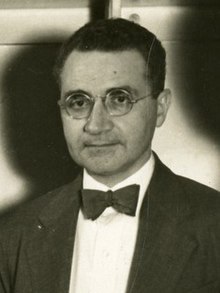Gioacchino Failla (19 July 1891 – 15 December 1961) was an Italian-born American physicist. A pioneer in both biophysics and radiobiology, he was particularly noted for his work on the role of radiation as a cause of cancer and genetic mutation. He was born in Castelbuono in the Province of Palermo and emigrated with his family to the United States in 1906. After his retirement from Columbia University's Center for Radiological Research in 1960, he was appointed Senior Scientist Emeritus in the Radiological Physics Division of the Argonne National Laboratory in Illinois. He was killed in a car accident near the laboratory at the age of 70.[1][2]
Gioacchino Failla
| |
|---|---|

Failla in 1937
| |
| Born | (1891-07-19)July 19, 1891 |
| Died | December 15, 1961(1961-12-15) (aged 70)
Downers Grove near
Chicago, Illinois, U.S. |
| Nationality | American |
| Alma mater | Columbia University Sorbonne |
| Known for | Biophysics Radiobiology |
| Awards | Pulitzer Scholarship Leonard Prize Janeway Medal Caldwell Medal Gold Medal of the Radiological Society of North America Ewing Society Medal American Cancer Society Annual National Award Judd Cancer Award |
| Scientific career | |
| Fields | Physics Health Physics Medical Physics |
| Institutions | Memorial Hospital (New York City, New York) Memorial Sloan Kettering Cancer Center Argonne National Laboratory |
| Doctoral advisor | Marie Curie |